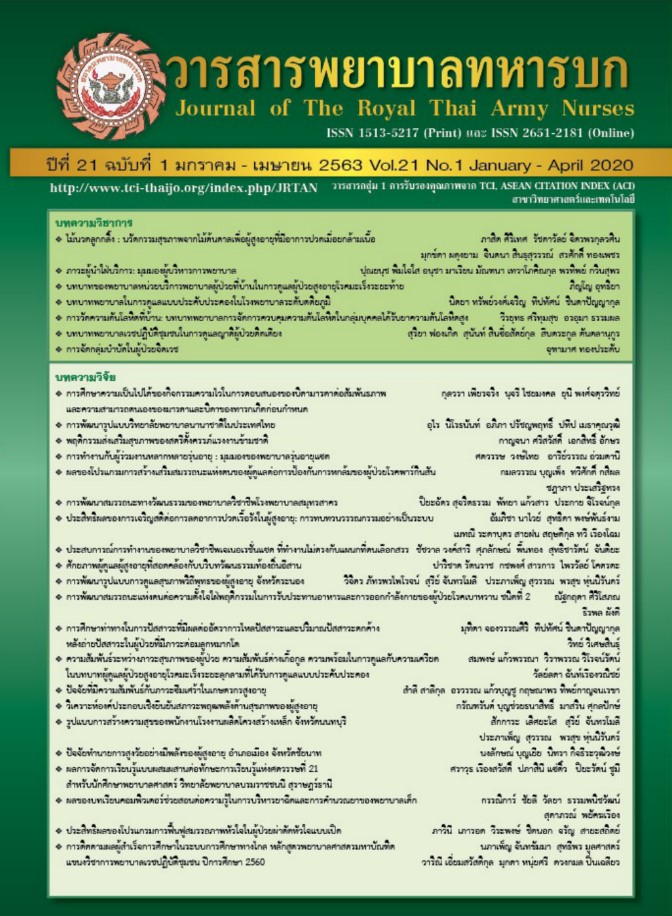Factors related to Depression among Agricultural Aging Workers
Keywords:
depression, agricultural aging workersAbstract
This descriptive study with cross-sectional design aim to examine factors relate to depression of agricultural aging workers. The samples were 364 aging workers. Research instruments include demographic questionnaire, agricultural work stress, interpersonal relationship problems, depression, blood cholinesterase (ChE) level, and digital blood pressure. Data was analyzed using descriptive statistic, Chi-square, and logistic regression.
Relationships between personal factors and depression among elderly agriculture workers for male gender were age, education, income, alcohol and cigarette use, high blood pressure, diabetes, and deaths of love ones. Whereas for female were age, education, income, marital status, chronic illness from high blood pressure or diabetes. Deaths of love one has significant relationship with depression of male worker. ChE level were found to have none significant relationship with depression among male and female aging agricultural workers. Logistic regression showed variables related to depression, for male were age, education, income, and illness from high blood pressure or diabetes. For female were age, education, marital status, and deaths of love one, (p<.05).
Downloads
References
O’ Hara MW, et al. Description and evaluation of the Iowa Depression Awareness, Recognition, and Treatment Program. Am J Psychiatry 1996;153:645-49.
Charney DS, Bermann RM, Miller HL. Treatment of depression. In: Schatzberg AF, Nemeroff CB, editors. Textbook of psychopharmacology. 2nd ed. Washington DC: American Psychiatric Press; 1998. p. 705-31.
Hemingway H, Marmot M. Evidence based cardiology: psychosocial factors in the etiology and prognosis of coronary heart disease. Systematic review of prospective cohort studies. BMJ 1999;318:1460-67.
Wassertheil-Smolle S, Applegate WB, Berge K, Chang CJ, Davis BR, Grimm RJ, et al. Change in depression as a precursor of cardiovascular events. SHEP cooperative research group (systolic hypertension in the elderly). Arch Intern; 1996.
Mc Gee R, Williams S, Elwood M. Depression and the development of cancer: a meta- analysis. Soc Sci Med 1994;38:187-92.
Buntinx F, Kester A, Bergers J, Knottnerus JA. Is depression in elderly people followed by dementia a retrospective cohort study based in general practice. Age Ageing 1996;25:231-33.
Unutzer J, Patrick DL, Simon G, Grembowski D, walker E, Rutter C, et al. Depressive symptoms and the cost of health services in HMO patients aged 65 years and older. A 4-year prospective study. JAMA 1997;277:1618-23.
Kessler RC, Stang, PE. Future directions is health and work productivity research. In Kessler RC, Stang PE, editors. Health and work productivity: making the business case for quality health care. IL: University of Chicago Press; 2006. p.271-86.
Thavichachart N, Lueboonthavatchai, P. Effects of psychoeducational on knowledge, attitude, practice, and psychological stress of patients with alzheimer’s disease. Chula Med J 2001;50(8):541-53.
Watterson A. Pesticide health and safety and the work and impact of international agencies: Partial successes and major failures. Int J Occup Environ Health 2001;7(4):339-47.
Bureau of Epidemiology. Annual epidemiological surveillance report 2007. Ministry of Public Health; 2008.
Fiedler N, Kipen H, Kelly-McNeil K, Fenske R. Long-term use of organophosphates and neuropsychological performance. Am J Ind Med 1997;32(5):487-96.
Arcury TA, Quandt SA, Mellen BG. An exploratory analysis of occupational skin disease among Latino migrant and seasonal farm workers in North Carolina. J Agric Saf Health 2003;9(3):221-32.
Mc Cauley LA, Anger WK, Keifer M, Langley R, Robson MG, Rohlman D. Studying health outcomes in farmworker populations exposed to pesticides. Environ Health Perspect 2006;114(6):953-60.
Roberts RE, Lee ES. Occupation and the prevalence of major depression, alcohol, and drug abuse in the United States. Environ Res 1993;61:266-78.
Lynch A, Glod CA, Fitzgerald F. Psychopharmacologic treatment of adolescent depression. Archives of Psychiatric Nursing 2001;15(1):41-7.
Weissman MM. Juvenile-onset major depression includes childhood-and adolescent-onset depression and may be heterogeneous. Archives of General Psychiatry 2002;59: 223-24.
Daniel, WW. Biostatistics: a foundation for analysis in the health sciences. New York: Wiley & Sons; 1995.
Nabkasorn C. Depression: pathology and nursing. Chonburi: Chonburi printing; 2018.
Marina BP, Helle RA, Philippe G. Potential development neurotoxicity of pesticides used in Europe. Environmental Health 2008;7(50):1-22.
Jaffee WB, D’Zurilla TJ. Personality, problem solving and adolescent substance use. Behavior Therapy 2009;40:93-101.
Comijs HC, Kriegsma DMW, Dik MG, Deeg DJH, Jonker C, Stalman WAB. Somatic chronic diseases and 6-year change in cognitive functioning older persons. Archives of Gerontology and Geriatrics 2009;48:191-6.
Matson JL, Neal D. Psychotropic medication use for Challenging behaviors in persons with intellectual disabilities: An overview. Research in Developmental Disabilities 2009;30:572-86.
Veselska Z, Geckova AM, Orosova O, Gajdosova B,van Dijk J P, Reijneveld SA. Self-esteem and resilience: The connection with risky behavior among adolescents. Addictive Behaviors 2009;34:278-91.
Downloads
Published
How to Cite
Issue
Section
License
บทความหรือข้อคิดเห็นใดใดที่ปรากฏในวารสารพยาบาลทหารบกเป็นวรรณกรรมของผู้เขียน ซึ่งบรรณาธิการหรือสมาคมพยาบาลทหารบก ไม่จำเป็นต้องเห็นด้วย
บทความที่ได้รับการตีพิมพ์เป็นลิขสิทธิ์ของวารสารพยาบาลทหารบก
The ideas and opinions expressed in the Journal of The Royal Thai Army Nurses are those of the authors and not necessarily those
of the editor or Royal Thai Army Nurses Association.






